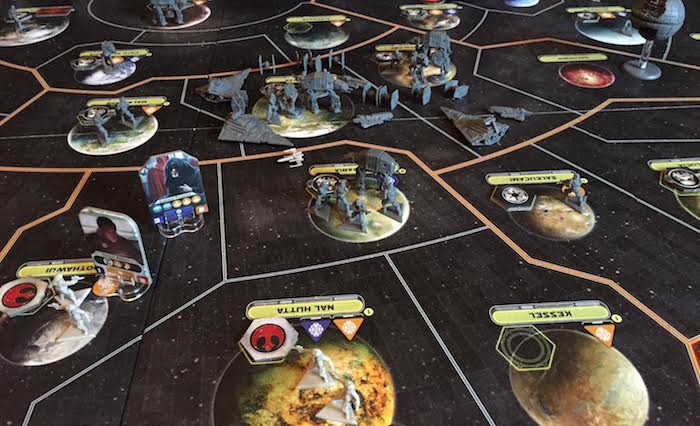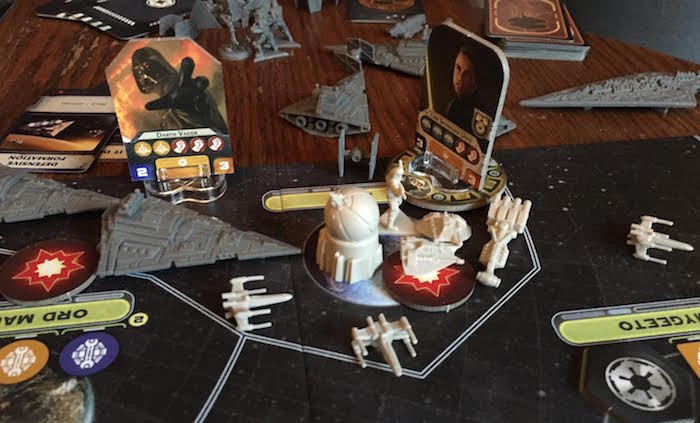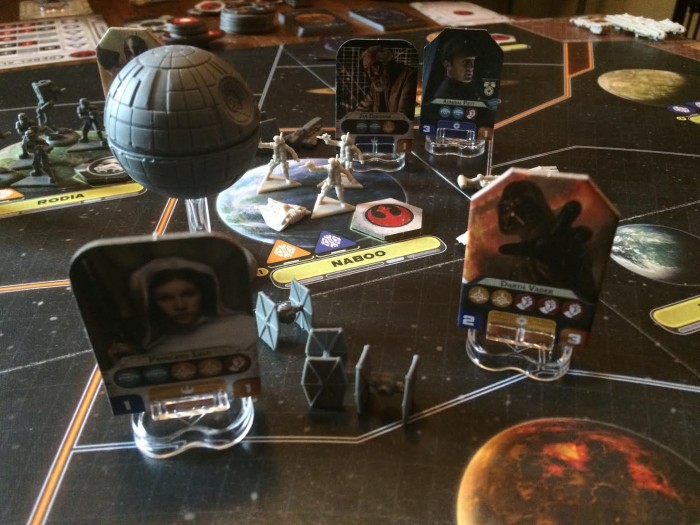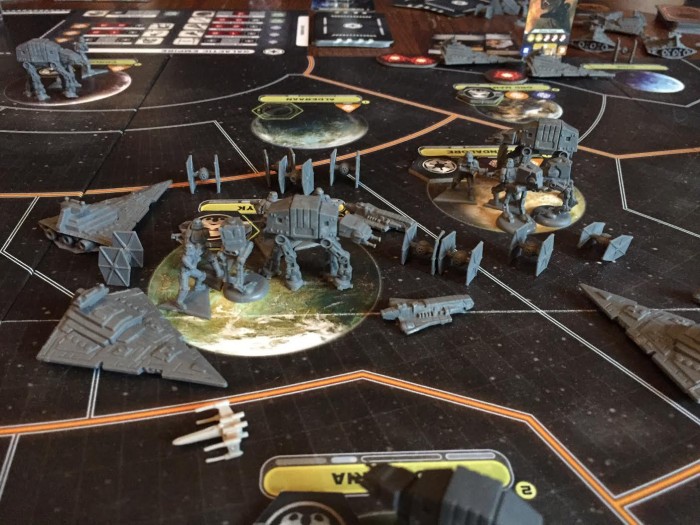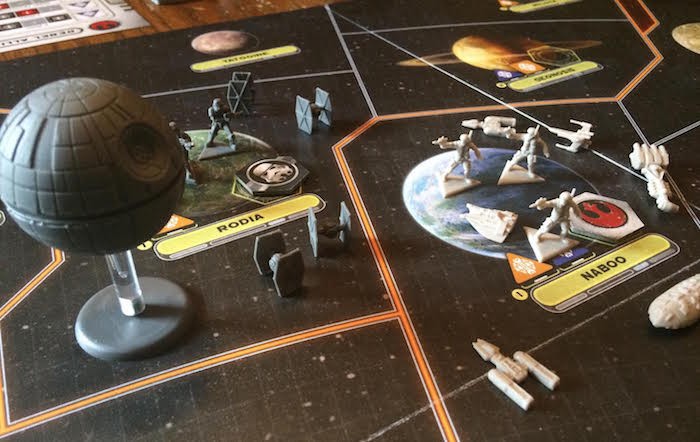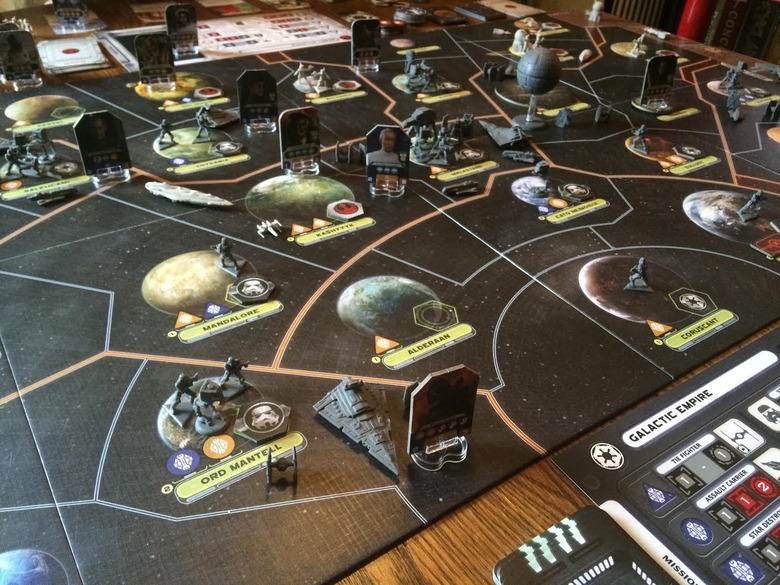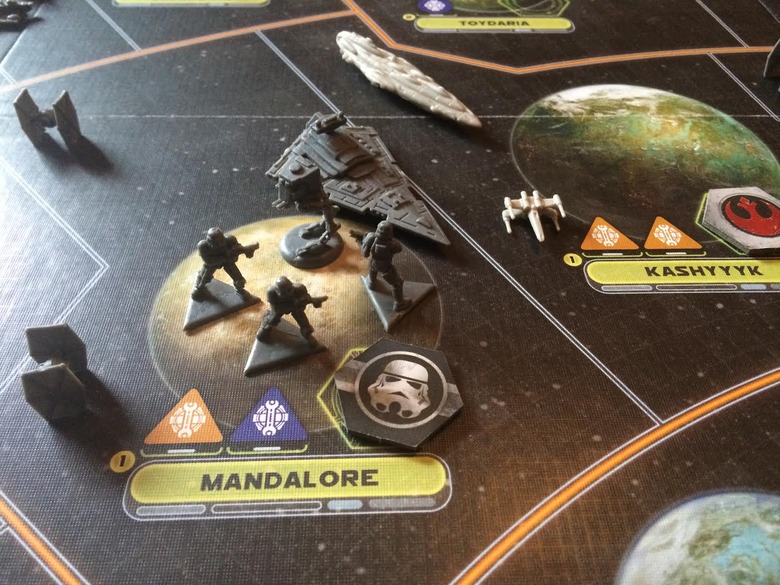Cardboard Cinema: 'Star Wars: Rebellion' Is The Best 'Star Wars' Board Game Ever Made
There's no need to bury the lede here – designer Corey Konieczka's Star Wars: Rebellion is the best Star Wars board game ever made and a complete triumph on every level. It's rare to find a tabletop experience that is this rich in theme while supplying gamers with genuinely compelling and balanced mechanics that enhance and support that theme every step of the way. Star Wars: Rebellion isn't just an effective Star Wars simulator. It's a surprisingly elegant and complex experience where each and every one of your decisions carries weight and feels important. It's an excellent game beyond its theme. This is a game of desperation and strategy, of giant battles and skillful detective work, of hope and luck.
And it's also a game where Darth Vader can abduct Mon Mothma and freeze her in carbonite after using the Death Star to blow up Naboo.
The Overview
Star Wars: Rebellion is the fourth Star Wars game published by Fantasy Flight Games, following X-Wing Minatures Game, Star Wars: Armada, and Star Wars: Imperial Assault, each of which are also excellent. Like those games (and like many other flagship FFG games), it looks intimidating on first glance. The box is huge, the two rule books potentially intimidating, and the $99 price tag steep. Although the game isn't nearly as rules-complex or brain-burning as other popular games, it's not an experience you step into lightly. There's some level of commitment involved here.
But it's worth it. The appeal of Star Wars: Rebellion is immediately recognizable as soon as you open the box, unfold the two gigantic game boards that you place side-by-side to create a map of the Star Wars universe, and start sorting through the mountain of plastic figures and cards that come with the game. This is the original Star Wars movie trilogy transformed into a sandbox. The elements are familiar – the planets include Coruscant and Tatooine, the characters include Boba Fett and Han Solo – but you're not beholden to the films in any way. Unless you want to be. This is your chance to rewrite the plot of the original films as you see fit. This is your chance to correct the mistakes that the Rebel Alliance made during their war against the Empire...or your chance to actually crush the rebellion under the Imperial boot and keep the galaxy in line.
Two to four players take control of the Rebels and the Imperials and they go to war, battling for the hearts and minds of their war-torn galaxy. While the game may initially look like a "dudes on a map" war game that's all about throwing one army at another and decimating your opponent's units and taking over planets so you can build more armies to toss at your opponent, the actual game couldn't be more different. The masterstroke of Star Wars: Rebellion is that it's asymmetric – both sides of the conflict play differently from one another and win the game in completely different ways. While the Imperials have all of the resources in the universe and can build giant armies of unstoppable ships and walkers and troops and even up to two Death Stars, they can only win the game in one way: by finding the secret Rebel base and destroying it. And that is much easier said than done. Meanwhile, the Rebels are on the ropes from turn one, fighting tooth and nail to hold on to every resource, losing every single battle, constantly fleeing and hiding in the shadows and performing quick guerrilla attacks because that is all they're capable of doing. But as long as they hold on, as long as they last long enough and wait the Empire out, they win the game. All they have to do is survive.
It's one of the most thrilling games of tug-of-war I've ever seen on my table. The Empire player always looks like the clear winner...until they don't. The Rebel player always looks doomed...until they don't. Everything else in the game, from the plastic components on the board to the cards in your hand to the cardboard "leaders" who drive each and every one of your actions, backs up this dynamic.
Components
As you'd expect from Fantasy Flight Games, whose work often feels like the board game industry's equivalent to glossy Hollywood blockbusters, the components that come in Star Wars: Rebellion's mammoth box are top-notch. You can feel your guilt for dropping a hundred bucks on a single board game melt away as soon as you start placing your units on the map. Yes, you got what you paid for.
The stars of the show are the tiny plastic X-Wings, TIE Fighters, Mon Calamari Cruisers, Star Destroyers, Airspeeders, AT-AT Walkers and so, so much more that players can field and lead into battle. Although the sculpts aren't as intricate as what you'll find in FFG's X-Wing and Armada, they're a few steps above most comparable war games. There is no mistaking what any of these pieces are meant to represent and they hold up to scrutiny. They're perfect for your bird's eye view of this galactic conflict. Maneuvering a fleet of X-Wings and Y-Wings into battle against a Star Destroyer looks and feels dramatic because the representation of what's happening is so very clear. The component quality means there's nothing abstract going on, which means that every movement of your armies and fleets is inherently cinematic and exciting.
The component quality extends to the other aspects of the game as well. The giant board(s) require a sizable table, but it's worth the effort. This sprawling representation of the Star Wars universe depicts 32 planets, from Geonosis and Mandalore to Alderaan and Bespin. The size of the board gives you a thematic rush (look at the size of the galaxy you get to conquer/liberate!), but it also serves a utilitarian purpose. With plastic components as large and detailed as what you're given in the box, the amount of space you're given means your fleets have room to breathe. Unlike so many other war games, the Star Wars: Rebellion map never feels crowded or over-stuffed. It's just the right size.
Even more valuable than the board and your plastic units are your leaders. These standees (constructed from thick, glossy cardboard) play a major role in every turn you take and you'll be looking at them a lot. So thankfully, they're lovely, with each of them depicting a major or minor character from the Star Wars universe. And these aren't cheap-looking photos, but gorgeous illustrations. The effect is not only pleasing to look at, but thematically satisfying. When you pick up the Admiral Ackbar standee to send him on a secret mission, you aren't just placing a piece on the board...you're sending Admiral Ackbar on a secret mission.
Gameplay and Mechanics
Although there are a lot of moving parts in Star Wars: Rebellion, the game itself is surprisingly easy to learn once you know how to read it. Because the thematics are so clear and the nature of the conflict so instantly recognizable, the rules become second nature after a few rounds. It's a testament to how game design and theme can truly complement each other. Everything you do on the table clicks quickly because it makes thematic sense.
So here's how the game works in a nutshell. The Rebel player picks a secret base location from the Probe Droid deck and tucks it away. This is their hidden headquarters and if it gets destroyed, they lose the game. The Imperial player gets to draw cards from the Probe Droid deck every round, sometimes using special abilities to draw more. This way, through careful process of elimination (and thematically, by sending out Probe Droids to scout planets), the Empire can narrow down where they need to hunt.
This secret base forms the core of the conflict, but the turn counter on the side of the board is what really gets you biting your nails. A game round token is placed on the first space on the turn counter when the game starts. A Rebel "Reputation" token is placed on space fourteen. With each round, that first token moves up. Meanwhile, the Rebel player uses their hand of "objective cards" (more on them in a bit) to move their Reputation tracker down. If the two tokens ever meet, the game instantly ends in a Rebel victory. In other words, the all-powerful Imperials have to race against the clock if they hope to put down the rebellion in time.
Gameplay itself is divided into three phases. First, players assign their various leaders (like Luke Skywalker and Emperor Palpatine) to various mission cards, which they place facedown on the table. These missions, if successful, give the player a bonus of some kind. Maybe they gain the loyalty of a planet. Maybe they get to capture and interrogate another leader. Heck, maybe they're activating the Death Star and intend to blow up an entire planet. Leaders can also be left unassigned for other reasons.
Then the players take turns activating one leader at a time. You can reveal a mission card and attempt to pass it, but many mission cards can be opposed by another player...as long as they kept a leader unassigned and in reserve. Each mission is coded as being diplomatic, military, logistics, or intel and since not every leader is capable of going on every mission, you're encouraged to make use of a variety of your leaders in every turn. Darth Vader is a military wrecking ball, but you won't be sending him on any spying missions any time soon. Unassigned leaders can also be used to command troops in the field and move them across the board. If you want to maneuver troops from one system to another, a leader must be present. If you want to attack another player's fleet or army, a leader must be present.
Knowing which leaders to send on missions and which leaders to keep in reserve to combat other missions and lead your armies ultimately forms the heart of Star Wars: Rebellion. Eventually, you'll command up to eight leaders, giving you more and more options with every turn.
And then there's a refresh phase where leaders are retrieved, mission cards refreshed, new troops deployed and so on. While there are many little details to keep track of and the make-up of mission cards ensures that every turn will be wildly different, every round will follow this game basic pattern. Once you find the groove, it's effortless.
If there's one downside to Star Wars: Rebellion's otherwise elegant and brisk design, it's the combat, which is a fairly underwhelming dice contest. Although certainly more compelling than a game of Risk, your armies clashing ultimately comes down to whoever rolls the better symbols – the hand of tactics cards you can utilize for having the right leader in the battle doesn't add much (and feels like a watered-down version of the far more compelling system Fantasy Flight Games used in last year's stunning Forbidden Stars). Thankfully, combat is secondary in this game. You'll be threatening to fight more often than actually fighting. Spying and deceiving and undermining each other play a far more prominent role in the game having out-and-out battles. And when fights do happen, they tend to end fast enough, letting you get back to the good stuff as soon as possible.
And one more note: while the box says four players can play Star Wars: Rebellion, the multiplayer game is just two players each controlling one side and working in tandem. With the right partner, this can be pretty fun, but the two-player game really sings. It plays significantly faster and you don't have to worry about a miscommunication with your partner totally screwing up a strong turn. Then again, that kind of silliness can also be a lot of fun as long as you have the right group.
The Imperials
As mentioned above, Star Wars: Rebellion is an asymmetric game, with each side behaving and playing differently than the other. Playing the Rebels like they're the Empire and vice versa will result in instant annihilation. The differences between the two sides creates a genuinely unique conflict, a war between a lumbering Goliath and an agile David.
Even the rulebook spells it out for you: the Imperials have everything they need handed to them on a silver platter. They begin the game with enough troops to dwarf the Rebel alliance. They begin the game with enough resources to continuously build more and more units every round. Taking over planets and acquiring new resources is as easy as landing ground troops on the surface and subjugating the people (who can later be turned fully loyal using a diplomatic mission card). A few rounds into the game, the Imperial player will dominate half of the board, coating the galaxy in Walkers and Stormtroopers and Star Destroyers. Heck, you begin the game with the Death Star, which is literally invincible unless the Rebels have found the right cards (what a theme, eh?). And then you may get the opportunity to field a Super Star Destroyer. And maybe a second Death Star. And yes, you can blow planets into dust, especially those that are home to Rebel strongholds.
Playing as the Empire makes you feel strong. It makes you feel untouchable. In the early rounds of Star Wars: Rebellion, the Imperial player rolls over planet after planet and it feels amazing. And then you start to realize that wiping out those Rebels on Geonosis got you no closer to finding their secret base. And you watch in annoyance as Wedge Antilles sabotages your factories on Corellia, keeping you from adding another Star Destroyer to your fleet this turn. You effortlessly withstand a puny Rebel attack and your enemy flees after one round of combat...only for them to realize that they only needed to survive a battle with you to win a Reputation point.
And that point moves their Reputation tracker down. One step closer to the round marker. And you still have no idea where the Rebel base could possibly be. And then you do find it and you surround it with ships and you plan to assault and...the Rebel player uses a special mission to move his base. And the hunt begins anew. It's easy to play as the Empire and use your armies to crush the Rebels and dominate the galaxy. It's not-so-easy to play detective, to find ways to manipulate the Probe Droid deck to narrow your options. After all, if your fleets aren't pointed in the direction of the hidden Rebel base, you're going to lose.
Playing Star Wars: Rebellion as the Imperials is like playing as an elephant assigned to deal with a rat infestation. It's thrilling and it's terrifying.
The Rebels
While the Imperials begin each game with the confidence that accompanies the ability to destroy an entire planet and slowly descend into abject, sweaty terror, the Rebels follow the opposite trajectory. They begin the game completely overwhelmed – outmatched and outgunned and outspent, all they can do is retreat the empty corners of the galaxy and launch potshots at the enemy. In several of my Star Wars: Rebellion games, Rebel troops were completely wiped off the board, with only a few stragglers left on the hidden base.
And yet the Rebels can still win. Because as the game goes on and as the Empire fails to achieve their one and only path to victory, the Rebels gain the upper hand. If they can stay out of the enemy's reach, and if they can do just enough to tip the scales and convince the galaxy that they stand a chance in this war, they will win.
While the Imperial player has a Death Star and Super Star Destroyers and cards that let them amass planets and and resources with ease, the Rebel player has the objective deck. This is their key to victory. Each of these cards features a goal and it's usually something fairly simple or straightforward: start a fight and kill two enemy units (you don't even have to win the whole battle), destroy a Star Destroyer (even though you may die in the process), have troops on five different planets (even if they're not loyal to the Rebel cause). If the Rebel player achieves these, they gain Reputation points. And Reputation points bring their Reputation marker closer to the round tracker, which means that these tiny victories eventually add up and can end the game before the Empire can get their act together. How amazing is that? The Rebel player can win the entire game without a definitive victory on the battlefield.
Of course, out-lasting the Imperial player is easier said than done, as they have the resources to throw everything they have at you. The Rebel player must watch as their few precious ships are decimated by an enemy whose production process is effortless. They must struggle to turn planets to their side, only to watch Stormtroopers land on the surface and undo their efforts instantly. They can't do much about the Death Star that can erase systems from the map.
Except they can play the objective card that allows them to "gain sympathy" and earn points for every destroyed planet. That's the Rebel way – you use the power of the Empire against itself.
Telling a Story
Star Wars: Rebellion is inherently dramatic because of the nature of the conflict on the board. You watch X-Wings fly against a swarm of TIE Fighters and your imagination fills in the blanks. However, this game is more than collection of dramatic moments – it is a story. Your story. Your version of the original Star Wars trilogy, remixed as you see fit. In your game, Alderaan lives while Kessel gets annihilated. In your game, Luke Skywalker never joins the fight and Obi-Wan Kenobi lives to see the end of the war. Heck, in your game, Han Solo is corrupted by the forces of the Dark Side and joins the Imperial cause. All of this is possible.
The truth is that Star Wars: Rebellion isn't a storytelling game like Tales of the Arabian Nights or even Arkham Horror, which is dripping with evocative text at every turn. The storytelling here is organic, emerging from gameplay mechanics naturally. You can play this is a strategy game, matching stats and making choices based on what will function best within the in-game mechanics, but everything really sings if you embrace the theme on every level. Sure, place General Dodonna on that mission because he's got the right abilities to make it happen, but embrace the fact that you've just sent General Dodonna on a mission! And if the other player tries to stop him, embrace the fact that Boba Fett has arrived to personally stop him!
I vividly remember one encounter that could be described as a series of actions and counter-actions between players using their cards and abilities to gain the upper hand. But that's not what happened. What happened was Princess Leia arrived on Kashyyyk to form an alliance with the Wookiees, but Emperor Palpatine himself arrived to intervene. He succeeded, and Leia's plans were crushed...but she was accompanied by the surprisingly reliable C-3PO, who turned things around at the last second. Furious at this turn of events, Darth Vader arrived and successfully captured Leia, imprisoning her on Kashyyyk and planning to relocate her to the heart of the Empire for safekeeping. But then Luke Skywalker created a distraction on an adjacent system, drawing the last unassigned Imperial leader to that position. With the path clear, Han Solo arrived in the Millennium Falcon, sprung Leia from prison, and retreated to the hidden Rebel base.
This is the kind of thing that just happens in Star Wars: Rebellion.
The Verdict
Here's how you know a board game is great: when it comes to an end and everyone starts packing up the pieces, all anyone can do is share stories from the game they just played. They agonize over their defeats and laugh about their craziest victories. They explain the strategies they were just about to do! The post-game conversation become a wave of "Do you remember when...?"
Each of my Star Wars: Rebellion games have ended this way. And each of them has ended with the other player(s) wanting to play again. I can't think of a better endorsement.

